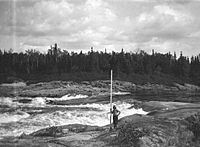| Revision as of 20:04, 22 October 2010 editP199 (talk | contribs)Autopatrolled, Extended confirmed users, IP block exemptions, Pending changes reviewers, Rollbackers55,454 edits add pic from commons← Previous edit | Revision as of 21:17, 29 October 2010 edit undoP199 (talk | contribs)Autopatrolled, Extended confirmed users, IP block exemptions, Pending changes reviewers, Rollbackers55,454 edits map addedNext edit → | ||
| Line 7: | Line 7: | ||
| | etymology = | | etymology = | ||
| <!-- *** Map section *** --> | <!-- *** Map section *** --> | ||
| | map = | | map = Manicouagan map.png | ||
| | map_caption = | | map_caption = Drainage basin in yellow | ||
| <!-- General section *** --> | <!-- General section *** --> | ||
| | country = Canada | | country = Canada | ||
Revision as of 21:17, 29 October 2010
The Manicouagan River is a river in Côte-Nord region of Quebec, Canada. The river originates at the Daniel-Johnson Dam of the Manicouagan Reservoir and flows approximately 200 kilometres (120 mi) south, emptying into the Saint Lawrence River near Baie-Comeau. Its headwaters are 560 kilometres (350 mi) from the mouth at the head of the Mouchalagane River.
The river's name, often abbreviated to Manic, is believed to come from a Montagnais word meaning "where tree bark is found". However the Innu of Betsiamites call it Menukuanistuk Shipu, which means "river of the cup".
Tributaries
The major tributaries of the Manicouagan River are in upstream order:
- Toulnustouc River
- Isoukustouc River
- Fontmarais River
- Lemay River
- Manicouagan Reservoir
- Mouchalagane River
- Seignelay River
- Themines River
History

At the end of August 1535, Jacques Cartier, while sailing south, noted the mouth of this large river but gave it no name. In June 1664, Jesuit Henri Nouvel was the first missionary to travel upstream of the "Grand Manikouaganistikou River that the French call rivière Noire because of its depth". The next year, he "returned to the mouth of the Manicoüagan in June." The river's spelling has remained fairly constant from then on.
In the early 1950s, the Manicouagan River attracted Hydro-Québec's attention for hydro-electric development because of the deep and fast running waters. In 1956, a dam was built at the mouth of Lake Sainte-Anne to regulate the Toulnustouc River, the main left tributary that empties in the Manicouagan between the Manic-2 and Manic-3 dams. Four years later, the main construction work began on the dams and power stations of the Manicouagan River and its neighbor to the west, the Outardes River. By 1978, this project, with a total power supply 4672 MW, was completed.
Hydro-electric dams
There are a number of hydroelectric power plants on the Manicouagan, part of the Manic-Outardes Project:
- McCormick generating station - 335 MW, owned by Hydro-Québec and Alcoa.
- Manic 1 generating station - 184 MW, operated by Hydro-Québec.
- Jean-Lesage generating station, formerly Manic-2 Power Station - 1024 MW, operated by Hydro-Québec.
- René-Lévesque generating station, formerly Manic-3 Power Station - 1244 MW, operated by Hydro-Québec.
- Manic 4 - Abandoned project
- Daniel-Johnson Dam:
- Manic-5 generating station - 1592 MW, operated by Hydro-Québec.
- Manic-5-PA generating station - 1064 MW, operated by Hydro-Québec.
References
- Cite error: The named reference
Atlaswas invoked but never defined (see the help page). - ^ "Rivière Manicouagan" (in French). Commission de toponymie du Québec. Retrieved 2010-10-20.
- Ministry of Natural Resources of Quebec and Hydro-Québec